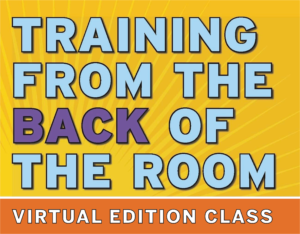“Small Trumps Large When Training Online” by Jean-Paul Bayley

How Big Should Your Live Virtual Class Be?
We have seen some grand claims that virtual training opens an opportunity to have very large classes. It’s an intoxicating thought. Online conferencing tools such as Zoom support many attendees, so why shouldn’t you? What does the research tell us?
As you can imagine, the experts don’t all agree. What I have read is that smaller is usually better. Just because a system allows 100 attendees, should you? To quote my fellow PST Simon Reindl, “Sure, you can run with scissors, but should you?”
What Does the Research Say?
The research splits several ways. One aspect is that the cognitive load on the trainer increases as the class sizes increases (a good enough reason to consider pairing with another trainer or “producer” who manages the technology while you facilitate the class). Another is that how can you, as a trainer, be sure that what you have taught will stick with your learners?
That last question feels like a slippery slope, so let’s return to the research. What many professionals agree on is that, if you want to engage learners in live-streaming classes, then class sizes should be no more than 12-20 students (Boettcher, 1999; LaBorie & Stone, 2015; Politis & Politis, 2016). In fact, some go even further and suggest that this range should be 12-15 students maximum (Benshoff & Gibbons, 2011; Haynie, 2014; Taft, Kesten & El-Banna, 2019).
Pedagogical Intent
Another powerful aspect of this research is pedagogical intent. Simply put, the depth and complexity of the course matter should influence your choice on class size. As one study put it:
Findings reflect that large classes (≥ 40 students) are effective for foundational and factual knowledge acquisition requiring less individualized faculty–student interaction. Small classes (≤ 15 students) are indicated for courses intending to develop higher order thinking, mastery of complex knowledge, and student skill development. Pedagogical intent should dictate class size.Taft, S., Kesten, K. & El-Banna, M. (2019)
What does this mean? If all you need to do is inform participants of facts (aka: a lecture “broadcast”), then go large. If you need people to learn something complex, go small. Research indicates that this is also the case for in-person training (but that’s for another post).
CONCLUSION: Optimum Class Size for Live Virtual Learning
To engage participants and optimise for learning in a virtual environment, keep your class size to 12 students or fewer. If the content you teach is firmly in the area of complex knowledge, then for this reason, limit the number of attendees in your online courses to 12. My training colleagues and I feel strongly that the science points us towards small class sizes and 12 is a reasonable maximum number to ensure good engagement and learning.
Suggestions for Success:
We have a few ideas you can try for the class management of groups in a live virtual class.
1. Breakout Rooms
Many online communication platforms have some feature whereby learners can be divided into smaller live-streaming groups. Use this feature to provide opportunities for small group collaboration. I have found it useful to provide simple clear instructions and nominate a facilitator for each breakout room.
2. Meeting Cards
The amazing Lisette Sutherland published some Collaboration Supercards on her Collaboration Superpowers Website. Visual indicators like this are great. To complement these, my company is working on our own set of cards specifically for virtual training.
3. Chat Storm
When directing a question to the whole class, invite everyone do a “Chat Storm,” whereby they all write their responses in the chat box but they don’t post their answers until you give a signal to do so. At that point, students post their answers all at once. Then you give them a couple of minutes to silently read all the chat box posts.
4. Pass the Mic
During activities like a Shout Out or a Conversation Café, get participants to nominate the next person to go. They can use a physical object to represent a microphone and pretend to speak into it, then pretend to “pass the mic” to the next person. Of course, a student can always exercise their “right to pass” if they wish.
About the Author:
 Jean-Paul Bayley, England
Jean-Paul Bayley, England
TBR Certified Trainer Jean-Paul Bayley is a partner of Actineo Consulting LLP – a Business Agility Consultancy. Jean-Paul’s mission is to share how to create fun, engaging and memorable learning experiences. Using the skills that he has honed during his career as a consultant, coach, and trainer, he now helps individuals, teams, and organizations achieve their professional goals. He has written a number of other blog posts for Sharon Bowman’s website:
When Everything is Suddenly Virtual
Psychological Safety and C1-Connection Activities
3 Anti-Patterns of Training
Anti-Patterns of Training – Part Two
TBR, Psychological Safety, and C1-Connection Activities
You can follow Jean-Paul on Twitter @jpbayley.
Leave a Comment/ Live Virtual Classroom / By
********************************
********************************
Bibliography
Artz, J. (2011). Online courses and optimal class size: A complex formula. Online Submission. Retrieved from http://files.eric.ed.gov/fulltext/ED529663.pdf
Benshoff, J.M. & Gibbons, M.M. (2011). Bringing Life to e-Learning: Incorporating a Synchronous Approach to Online Teaching in Counselor Education. The Professional Counselor 1(1). Retrieved from https://files.eric.ed.gov/fulltext/EJ1063069.pdf.
Boettcher, J.V. (1999). Cyber course size: Pedagogy and politics. Syllabus, 12 (8), 42-44. Rerieved from http://designingforlearning.info/writing/how-many-students-are-just-right-in-a-web-course/
Haynie, D. (2014). Experts Say Class Size Can Matter for Online Students. US News. Rerieved from https://www.usnews.com/education/online-education/articles/2014/09/26/experts-say-class-size-can-matter-for-online-students.
LaBorie, K. & Stone, T. (2015). Interact and Engage!
McDaniels, M., Pfund, C. & Barnicle, K. (2016). Creating Dynamic Learning Communities in Synchronous Online Courses: One Approach From the Center for the Integration of Research, Teaching and Learning (CIRTL). Online Learning 20(1). Retrieved from https://nrmnet.net/wp-content/uploads/2016/03/synchronous-online-courses-manuscript-Online-Learning.pdf.
Morrison, D. (2015). Does Class Size Matter in Online Courses? Three Perspectives: The Economist, Instructor & Student. Retrieved from https://onlinelearninginsights.wordpress.com/2015/01/14/does-class-size-matter-in-online-courses-three-perspectives/.
Politis, J.D. & Politis, D.J. (2016). The Relationship Between an Online Synchronous Learning Environment and Knowledge Acquisition Skills and Traits: The Blackboard Collaborate Experience. Computer Science 2016. Retrieved from http://www.ejel.org/issue/download.html?idArticle=507&usg=AOvVaw123tIoXrHaNrFyqHZ9I-u8.
Taft, S., Kesten, K. & El-Banna, M. (2019). One Size Does Not Fit All: Toward an Evidence-Based Framework for Determining Online Course Enrollment Sizes in Higher Education. Online Learning 23(3). Retrieved from https://files.eric.ed.gov/fulltext/EJ1228823.pdf.
